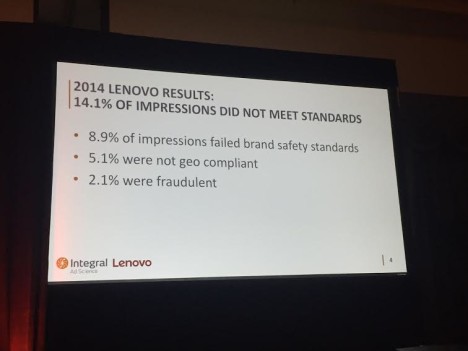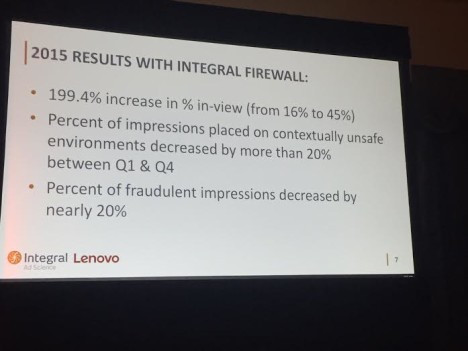Lenovo global digital boss: too many marketers are paying to reach the wrong online audiences
The chief global digital marketer for computer brand Lenovo has warned brands need to check premium publishers are delivering on basic promises such as achieving the right geolocations for their campaigns.
Speaking at the ANA Advertising Financial Management conference in Boca Raton, Florida, Gary Milner told the forum about his frustration with some online delivery, noting how even campaigns bought from major publishers were not being delivered correctly.
“It’s not just on programmatic but also on premium inventory,” said Milner, noting that despite some programmatic exchanges having a reputation for poor delivery this error had occurred with a major US publisher.
“It was only 10% of the inventory but it was 20% of the cost that was being served to the wrong geography.”
“We were serving ads (on a US campaign) to people coming in from India and Australia,” he said. “The important point here was that all of that was in the agency contract with the publisher – they were not to serve outside the country – but we had no way to monitor and enforce that.”
Lenovo is the world’s second largest computer manufacturer in the world, and Milner today showed the audience how its crackdown on key digital issues such as viewability, brand safety and geolocations, had dramatically improved the effectiveness of its online advertising spend.
“Brands need to ask themselves about the brand safety issues: are you running on the right sites (and) against the right material?,” he asked.
“Is your ad being seen at all? Is your ad being shown to a bot? There are a lot of ads being shown to bots. All of these things affect performance and it has a causal impact on your brand and, you may not realise it, but it will impact your business.
“If only 15-20% of your ads (are meeting standards) that could have a much bigger effect than probably your agency negotiations or costs.”
Milner took the room through a test it had done in 2014 which revealed issues in all three areas and that put it in the 15% bracket.
“When we ran a test, 9% of impressions did not meet safety standards, 2% were fraudulent – which isn’t bad, we had one company, who will remain nameless, who had 65% fraud on their campaigns – and then 5% were not geo-compliant.
 “The US were running their campaign through a premium vendor where the whole 5% went through one publisher, and that was 20% of our total media buy.”
“The US were running their campaign through a premium vendor where the whole 5% went through one publisher, and that was 20% of our total media buy.”
Milner told the room they had now put in place solutions, including using Integral Ad Science, to monitor such key areas of concern and provide regular reporting and prevention.
“We put a solution in place that now monitors those things”, he said. “For example, we monitor what percentage of ads we block from being served and then we monitor how much money we are saving by blocking against, say, fraudulent ads.
“If you look at our results we have had an almost 200% increase in viewability and a 20% decrease in both unsafe ads and in fraud all while achieving a seven-times return. For every dollar we put in we get $7 back.”
 Milner told the room that like many marketers around the world he was rapidly increasingly his media spend in programmatic advertising but that he needed to know the money wasn’t being wasted.
Milner told the room that like many marketers around the world he was rapidly increasingly his media spend in programmatic advertising but that he needed to know the money wasn’t being wasted.
“When we look at the commodisation of media buying, then programmatic (for us) is probably 50% of the media buying mix or more in digital.
“There are a number of areas where people are probably right to be concerned. One of the biggest areas of importance is your attention to detail on this type of thing. ”
Nic Christensen in Boca Raton





This is a great story about taking control of programmatic, and partnering with bet f breed solution providers. It’s about saying no to arbitrage and non-transparency. It’s a focussed buy the opposite of the spray n pray prospecting that many DSPs pitch. Good job Gary and Lenovo on taking control of the reigns and delivering huge improvements through working with IAS on brand safety, geo constraints and filtering out fraudulent inventory.
User ID not verified.
Levono. Really! proof read dudes.
User ID not verified.
Where is the proof of these data points, IAS doesn’t know the diff between a bot or human…
User ID not verified.
Agree cookie methods are riddled with fraud and inaccurate delivery. Try El Toro with patent pending ip match to offline data for one to one targeting. mike@eltoro.com
User ID not verified.
As usual some dum dum named Anonymous opens its mouth without thinking. What you are the guy that knows everything yet wants to be behind the scenes? Come out and show your name to be credible otherwise shut the F up cus you know nothing since you are.. of course…anonymous
User ID not verified.